Pains and Gains: Understanding Your Customer Needs
Published: 01 March, 2023
Experience Design
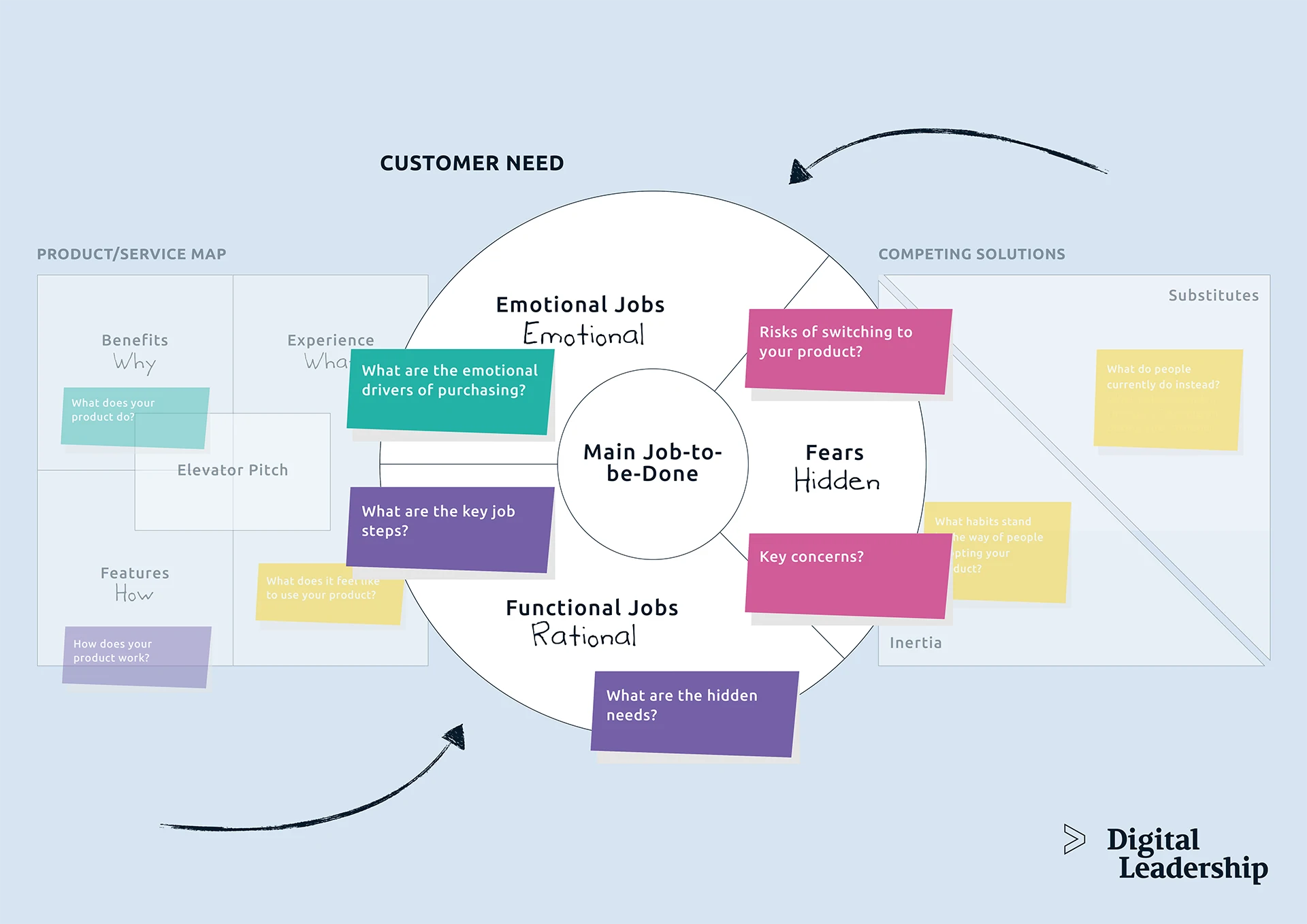
Table of Contents
The value proposition of any successful business is deeply tied into the pains and gains of the business’s specific customer segment. Market research should reveal what you can do to make the customer happy through pain relief and real gains.
As innovation teams do their work, they should revisit these pains and gains. In fact, no innovation should go far into development unless it directly addresses either new pains and gains revealed through understanding the customer more deeply or doing a better job of delivering on the pains and gains you already have recognized.
In this article, we consider how pains and gains for a segment of the value proposition canvas and why addressing your customers’ specific needs is so crucial to successful innovation. If you hope to make your innovation a real game changer, you need to have a deeper understanding of your customers’ key jobs and how you can help them complete them more successfully.
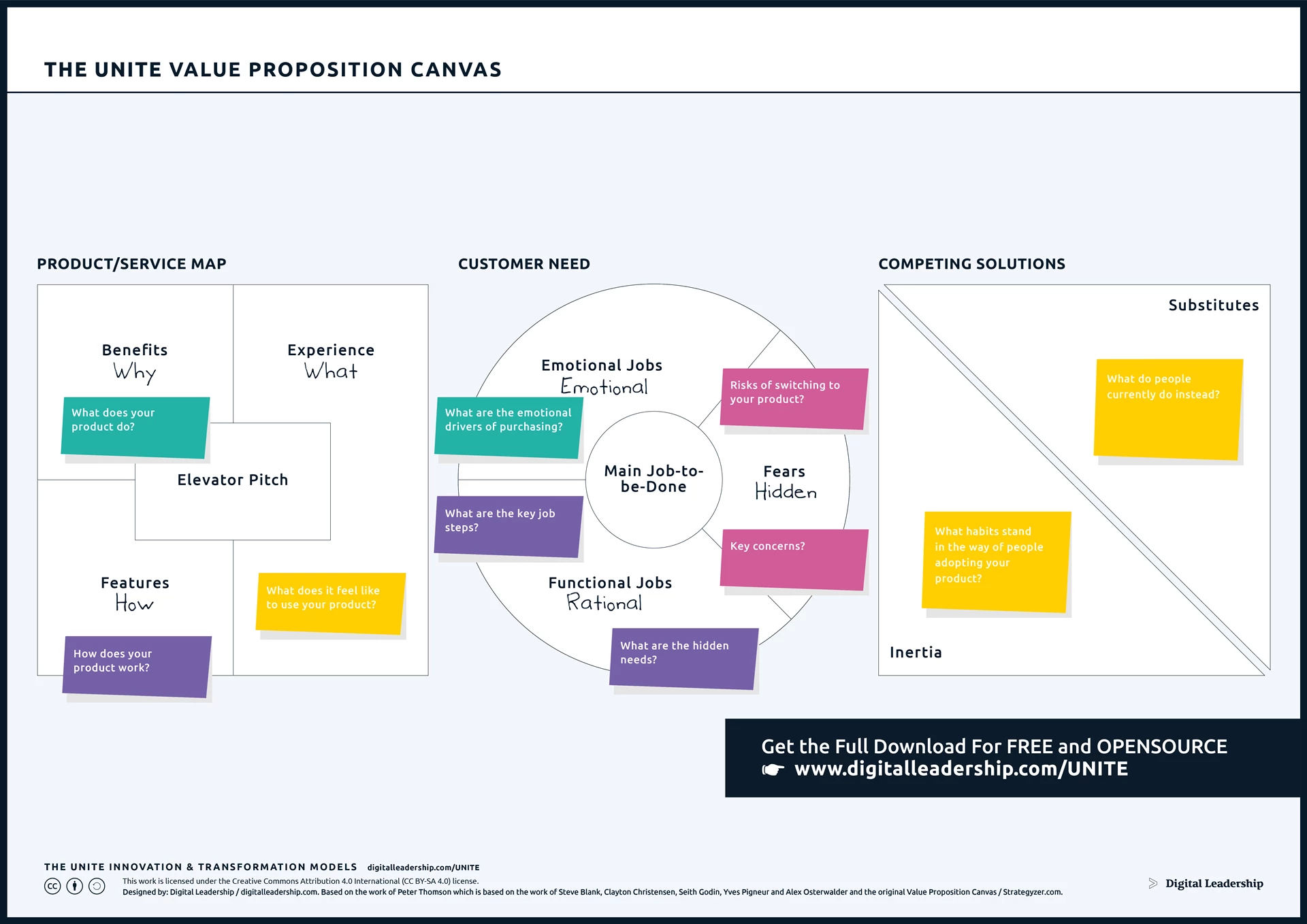
Designed by: Digital Leadership AG – Based on the work of Peter Thomson which is based on the work of Steve Blank, Clayton Christensen, Seith Godin, Yves Pigneur and Alex Osterwalder and the original Value Proposition Canvas
What are Customer Pains and Gains?
It’s a mistake to look at the terms pains and gains and assume they are the opposite of each other. While they are related, they are not two different sides of the same coin.
So what are customer pains?
Customer pains or “fears”, many times called pain points, are persistent struggles and challenges customers face in their lives or in their business. From a business perspective, customer pains are an inconvenience on a customer’s way to completing their value proposition. Customer pain may come from services they can’t manage themselves, poor availability of resources, undesired costs, maintenance worries, or any number of other concerns that distract them from their main goals, value propositions, or core activities.
Customer pain “fears” may also include negative emotions, either of the company’s people or with their own clients. If you can offer a way to relieve that pain, you have a potentially successful enterprise.
What are customer gains?
Customer gains help people save time, save money, finish their jobs to be done, feel good, or otherwise receive the benefits they desire. Customer gains are not necessarily the alleviation of pains, so pains and gains should not be strictly connected.
A customer expects services or products, but when you truly meet their wants and needs, you’ve made a connection that goes beyond a mere transaction. Understanding your customers’ pains and gains, and building them into your own value proposition, is an excellent way to move your business toward success. It takes some time, however, and you’ll need to explore each specific customer segment you wish to serve.
Customer Pains and Gains as Part of Your Main Jobs to be Done
No business exists in a vacuum.
With Jobs to be Done, you will be able to understand what pain your customers are really struggling with. We are seeking to understand an important but unmet user need, not ideas about solutions for customers we do not know yet.
In an independent study of different innovation methods, Strategyn, one of the companies which has developed and led the Jobs-to-be-Done approach, found that the success rate of their JTBD innovation approach was 86% compared to the average success rate of traditional innovation methods, which was 17%. The relative success of JTBD should not come as a surprise; a targeted innovation approach naturally outperforms most ideation/luck-based methods.
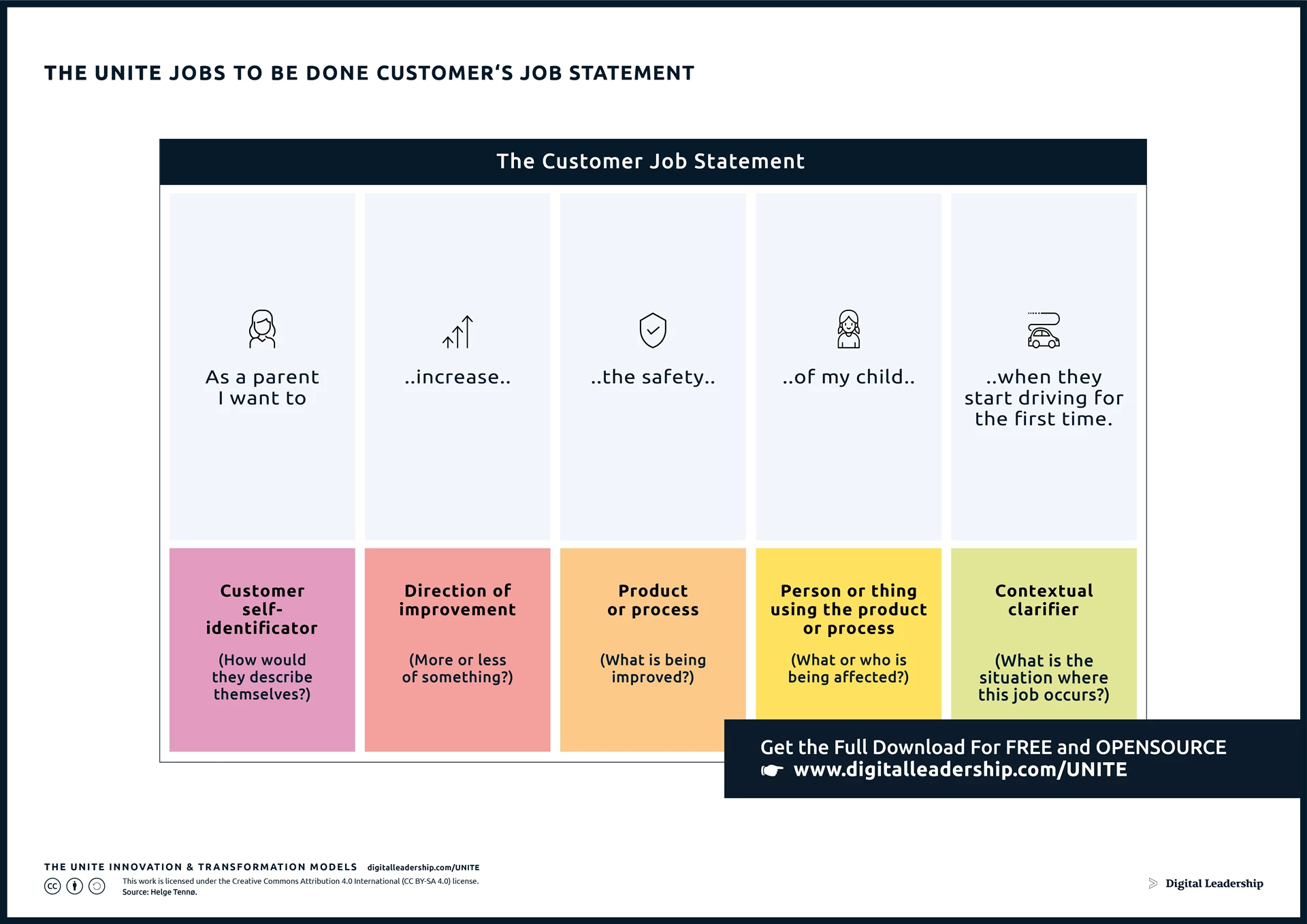
Designed by: Digital Leadership AG – Source: Helge Tennø.
But the process requires rigor. There is no point in going through all the hoops if we only end up making unproven, potentially biased assumptions about the customer based on our own gut feelings. This is why we recommend setting aside the necessary investments to include the customers in your work in a qualitative and quantitative way.
How can JTBD, Pains and Gains Inform Your Value Proposition?
The #1 problem when it comes to innovation is that we tend to analyze and understand the world entirely from the business’s own perspective. We lack the framework and mental models to include the customer in our conversations and decision-making. This cannot work and we see it in the numbers: most innovation projects fail.
The Jobs to be Done Approach offers two key insights:
- A mental model and a structured approach to understanding the needs of your customers (looking good instead of weight management, good entertainment instead of TV, leisure instead of a sailboat, etc.) and which criteria they use to measure the outcome.
- A methodology to identify the most important but underserved customer needs in a quantifiable and verifiable way. Basically, it helps you understand what outcomes customers truly value, but are not yet able to achieve.
Thereby JTBD gives you a verifiable and precise understanding of where you can innovate to solve a big unmet need and your progress towards a successful outcome.
How to Identify Your Customers’ Pains “Fears”
The emotional drivers of decision-making are things that we want to be, do or have. Our emotional jobs are usually conscious (but aspirational) thoughts about how we would like to improve our lives. They sometimes seem like daydreams, but they can be powerful motivators of action. In this case our desires are more abstract. I may need a car to get from point A to point B, but I want a BMW to demonstrate my success, social standing, or sense of taste. So, also consider emotional needs, such as self-actualization, social exchange/personal recognition and security/risk reduction.
Although fear is a type of emotion, it so powerfully affects decision-making, that it is worthwhile to consider it separately. The dark side of making a decision is that it often carries the fear of giving up optionality. There is also fear of making a mistake, fear of missing out, fear of loss, and dozens of other related fears. Fears can be a strong driver of purchasing behavior and can be the hidden source of wants and needs.
Customer pains “fears” are often the secret reason that no one is buying your widget. For any product, there is a secret “switching pain.” Even if your product is better than the competition, it might not be a big enough improvement to overcome the inertia of the status quo.
If you have a partial understanding of your customers through market research, completing a value proposition canvas can help you act upon what you know. How to Create Innovation provides useful frameworks for evaluating your overall business plan and value proposition. You can the book available on this website.
Identifying your Customer’s Jobs to be Done
If we as marketeers, decision-makers or product developers want to improve business results, we have to understand the jobs that arise in the life of our customers, for which they hire certain solutions. Understanding who these people are is the wrong unit of analysis. What we really want to know is what they are trying to get done. Unsurprisingly, the underlying theory behind this is called Jobs to be Done (JTBD). At the center of the theory is the “job:” a “job” is the fundamental problem a customer needs to resolve in a given situation.
The question JTBD asks is, why do your customers buy things from you? Do you think it is because you have the product with the highest specifications? Because you are the cheapest? Or is it due to your fantastic marketing department?
We focus on the “job” a user has to accomplish, instead of whatever artificial market segment they belong to.
Your value proposition design journey must include these jobs to be done if you hope to be successful. A business cannot exist simply because its founder thinks he or she has a good idea. Someone else must find that idea useful, and be willing to pay for it.
We use the proposition canvas to help guide proposition design. We find it’s beneficial to sketch out how we understand customer jobs and how our work fits into what customers need. We’re looking for synergy between how and what we do in business and what the people of our target market need done.
Above all else, remember that your market segment is made of people, people with concerns and needs and worries. Your key takeaway today should be that your efforts will only bear fruit by satisfying people.
Questions for Reflection
What do you know about the people who are within your selected customer segments? Have you built a customer profile?
What is the specific customer job you are completing?
Does your value proposition connect directly to customers’ pains and gains?
Have you built your value proposition design with customer value in mind?
How can you clearly articulate your value proposition so that it addresses specific pains and gains your customer’s experience or value?
The UNITE Business Model Framework: A Framework for Innovation Success
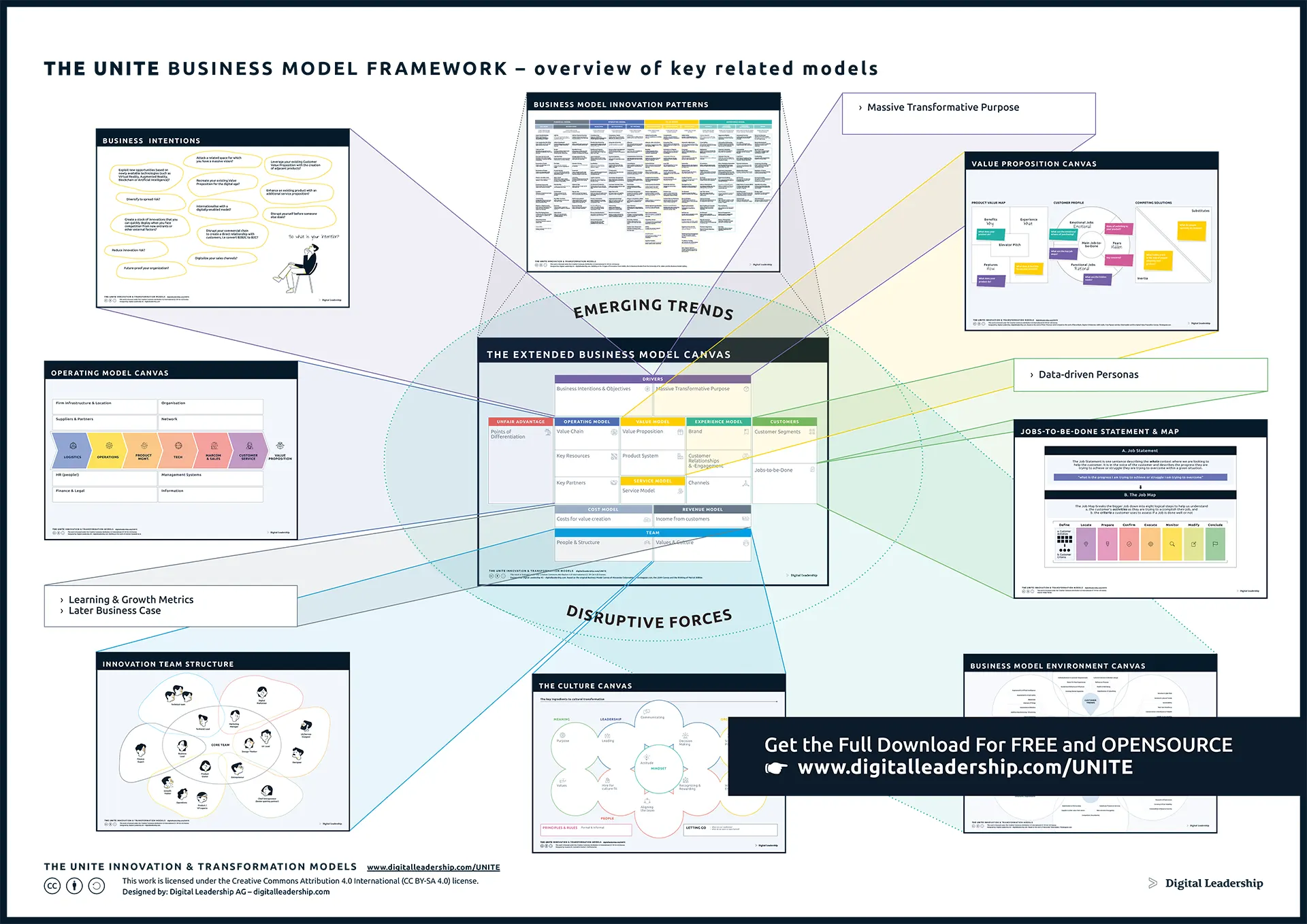
Designed By: Digital Leadership AG
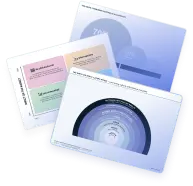
































 Book How to Create Innovation
Book How to Create Innovation